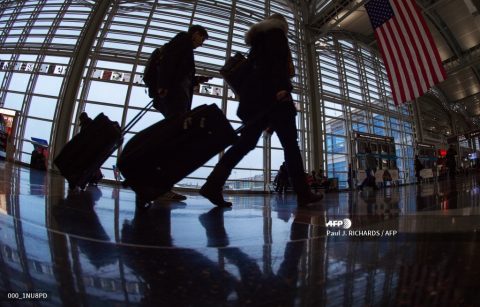
WASHINGTON, DC (AFP) — The US will begin screening passengers Friday arriving from a Chinese city at the heart of a mysterious SARS-linked virus, officials said, after an outbreak that has stricken dozens claimed a second life.
Three confirmed cases meanwhile have now been reported outside China — two in Thailand and one in Japan — even as health authorities around the world sought to assure the public that the overall risk of infection remained low.
Martin Cetron, a senior official at the US Centers for Disease Control and Prevention (CDC) told reporters: “To further protect the health of the American public during the emergence of this novel coronavirus, CDC is beginning entry screening at three ports of entry.”
These are San Francisco airport and New York’s JFK, which both receive direct flights, as well as Los Angeles, the biggest destination for connecting flights, he said, adding: “We’re expecting that the screening over the next couple of weeks could include as many as 5000 people” beginning Friday night.
Incoming travelers will be asked to fill out a questionnaire and submit to a temperature check, with those showing possible signs of infection sent on to another facility for a diagnostic test that could take up to a day.
The move came after Chinese officials said the infection had claimed its second death: a 69-year-old man who died on Wednesday in Wuhan, the central Chinese city believed to be the epicenter of an outbreak of the pathogen from the same family as the deadly SARS virus.
No human-to-human transmission has been confirmed so far, but Wuhan’s health commission has said the possibility “cannot be excluded.”
The enigmatic illness has caused alarm because of its connection to SARS (Severe Acute Respiratory Syndrome), which killed nearly 650 people across mainland China and Hong Kong in 2002-2003.
Pneumonia linked to the new virus has hit at least 41 people in China, with the outbreak centered around a seafood market in Wuhan.
Of these 12 have recovered and been discharged from hospital, according to the Wuhan health commission, while five others are in a serious condition.
The second man to die became sick on December 31 and his condition worsened two weeks ago, it said, with the disease causing pulmonary tuberculosis and damage to multiple organ functions.
Thailand reported its second case of the coronavirus on Friday: a 74-year-old Chinese woman who had arrived from Wuhan earlier this week.
Her condition is improving, said Thai health officials, who urged people not to panic as there was “no spread of the virus” in the Southeast Asian country.
– Travel fears –
That sentiment was echoed by senior CDC official Nancy Messonnier, who said: “For families sitting around the dinner table tonight, this is not something that they generally need to worry about.”
Yet much remains to be understood about the “2019 novel coronavirus” or “2019-nCoV,” according to the CDC, which added that “there are indications that some limited person-to-person spread may have occurred.”
The latest fatality comes as China prepares for its busiest travel season of the year next week, when millions of people take buses, trains and planes for Lunar New Year.
China has not announced any travel restrictions but authorities in Hong Kong have stepped up detection measures, including rigorous temperature checkpoints for inbound travellers.
The Wuhan health commission said one man who had been diagnosed worked at Huanan Seafood Wholesale Market, but his wife, who also had the virus, reported “no history of exposure” at the facility.
The first case in Thailand had not reported visiting the seafood market, the WHO said Tuesday. The woman was reported to be in a stable condition earlier this week.
The patient in Japan, who was released from hospital, had also not visited the market. Japanese officials said it was possible that the man had been in contact with a person infected with the virus while in Wuhan.
– Transparency –
After the second death was reported, online discussion spread in China over the severity of the Wuhan coronavirus — and how much information the government is hiding from the public.
Several complained about censorship of online posts, while others made comparisons to 2003, when Beijing drew criticism from the WHO for under-reporting the number of SARS cases.
“It’s so strange,” wrote a web user on the social media platform Weibo, citing the overseas cases in Japan and Thailand. “They all have Wuhan pneumonia cases but (in China) we don’t have any infections outside of Wuhan — is that scientific?”
But the CDC’s Messonnier thanked her Chinese counterparts for quickly identifying the pathogen and making its genome publicly available to scientists around the world, allowing them to rapidly develop diagnostic tools.
© Agence France-Presse
